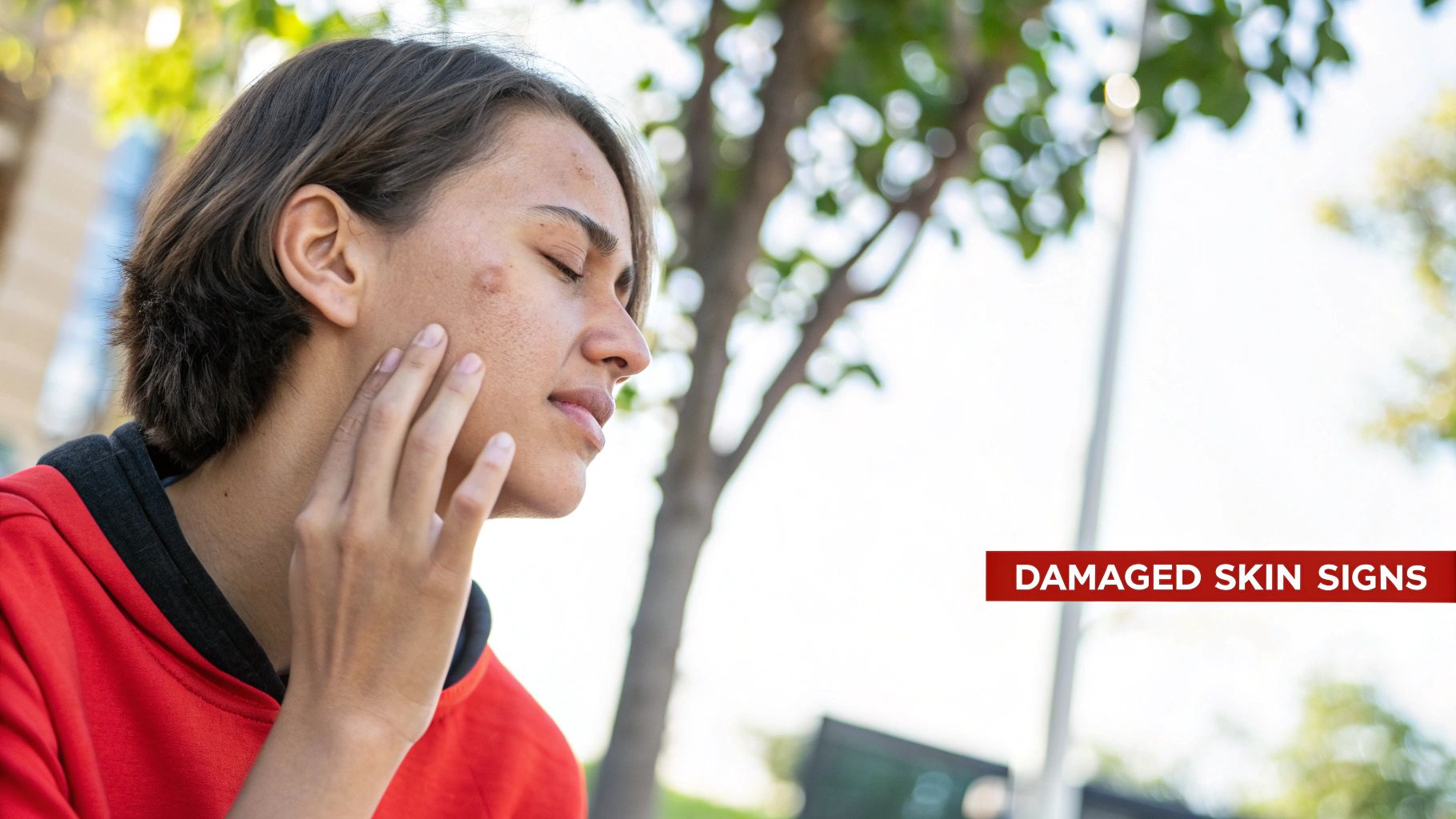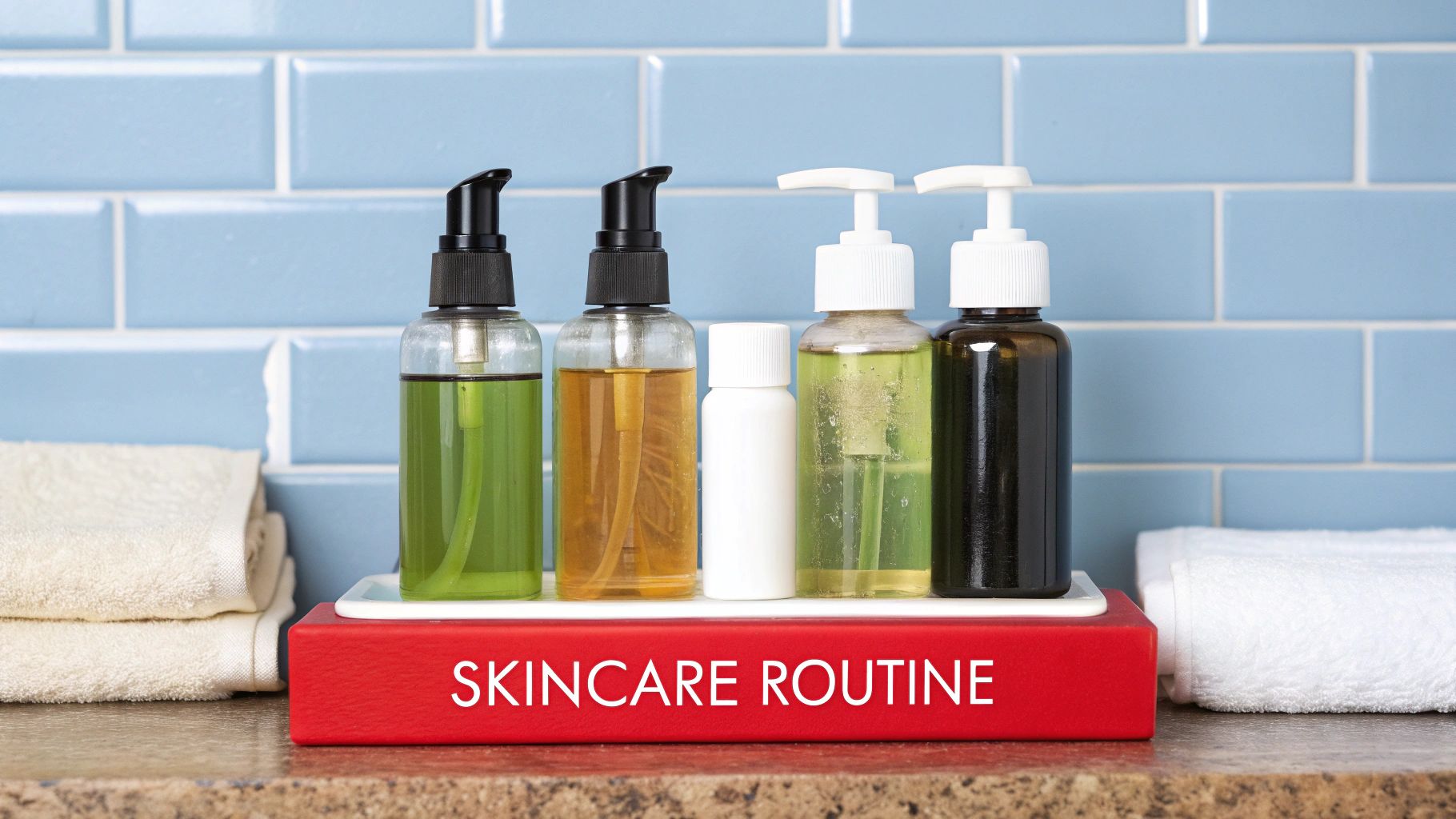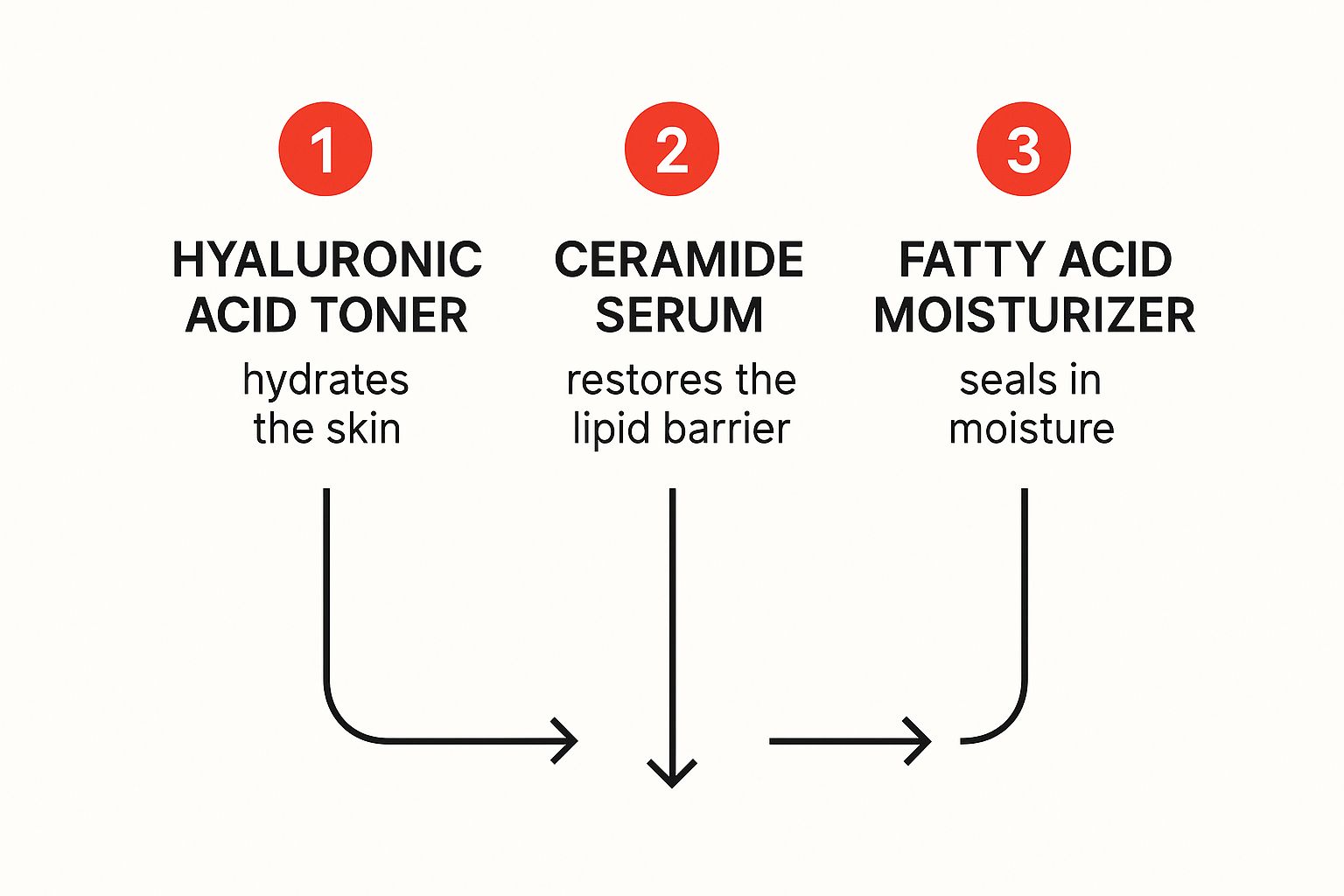
Repairing Skin Barrier: Tips for Healthier, Radiant Skin
Share
Understanding Your Skin Barrier (And Why It's Failing You)

Let's forget the complicated skincare terminology and talk about your skin barrier. Imagine it as your skin's loyal protector, keeping the bad stuff like irritants and pollution out, while locking in the good stuff like moisture. This barrier is essential for maintaining healthy, glowing skin.
But many of our daily habits can weaken this protective shield, leading to a variety of skin problems. Understanding how your skin barrier works is the first step toward restoring and safeguarding its health.
The Skin Barrier's Structure
Your skin barrier isn't a single layer, but a complex system, primarily residing within the stratum corneum, the outermost layer of your skin. It's made up of strong, flattened cells called corneocytes, bound together by a matrix of lipids, including ceramides, cholesterol, and fatty acids.
These lipids are vital for maintaining the barrier's strength and preventing water loss. In addition, your skin's acid mantle, a slightly acidic film on the surface, helps defend against harmful bacteria and maintain a balanced pH. This intricate structure works together to shield your skin from external aggressors.
Why Your Barrier Might Be Failing
Sadly, several factors can disrupt this delicate ecosystem. Over-cleansing, using harsh soaps, and even environmental factors like pollution and weather changes can strip away essential lipids and disrupt the skin's pH balance.
For instance, using hot water for cleansing can remove natural oils, leaving your skin feeling tight and dry. Over-exfoliating can also damage the stratum corneum, weakening the barrier.
These factors can leave your skin vulnerable, leading to dryness, irritation, and even inflammation. The importance of maintaining and repairing the skin barrier is underscored by the substantial cost and resources allocated within the UK healthcare system. Skin conditions collectively cost the NHS £723 million annually, with over three million primary care hours dedicated to managing these conditions. Find more detailed statistics here: https://pharmatimes.com/news/skin_conditions_cost_nhs_723m_a_year_1228662/
Recognizing a Compromised Barrier
A damaged skin barrier can show up in various ways. Dryness, tightness, and flakiness are common indicators. You might also experience increased sensitivity, redness, or even breakouts.
This occurs because a weakened barrier allows irritants to penetrate deeper into the skin, triggering inflammation and other problems. A compromised barrier can also worsen existing skin conditions like eczema and psoriasis.
These signs indicate your skin's natural defense system needs some serious care. Recognizing these signals is crucial for taking proactive steps to restore its function.
Signs Your Skin Barrier Needs Immediate Attention

Your skin communicates constantly, a living testament to your well-being. Are you truly listening to its messages? Beyond the noticeable dryness and irritation, there are subtle cues we often misinterpret as mere "sensitive skin" or signs of aging. These whispers, however, might be urgent pleas for help from a compromised skin barrier. Understanding these signals is crucial for restoring your skin's natural resilience and achieving a radiant, healthy glow.
Decoding Your Skin's Distress Signals
One clear indicator of a weakened skin barrier is a sudden stinging or burning sensation when using products you've previously tolerated. This heightened sensitivity suggests your skin’s protective shield is struggling. Perhaps your regular cleanser now feels harsh, or a once-nourishing serum now irritates. These reactions signal that your skin's protective layer isn’t functioning optimally.
Persistent dullness, even with the help of high-quality serums, is another common sign. A healthy skin barrier reflects light beautifully, creating a natural luminosity. A damaged barrier disrupts this reflection, leading to a lackluster appearance. Unexplained breakouts, particularly in areas where they’re uncommon for you, can also indicate a compromised barrier.
Why Some Skin Seems “Bulletproof” (and Yours Doesn’t)
Ever wondered why some people's skin seems resilient to irritants while yours reacts to seemingly everything? The difference often lies in the strength of the skin barrier. A robust barrier effectively repels external aggressors, while a weakened one allows them to penetrate and disrupt the delicate balance of your skin. Factors like genetics, lifestyle, and environmental exposure contribute to this variation.
Hormonal fluctuations, certain medications, and even chronic stress can impact your barrier's resilience. For instance, changes in estrogen levels can cause dryness and increased sensitivity. This highlights how factors beyond your skincare routine can significantly influence barrier health. For those with sensitive skin, finding the right routine can be especially important. Learn more in our article about How to master a skincare routine for sensitive skin.
Assessing Your Barrier Health
How can you definitively tell if your skin barrier is compromised? Look for these key indicators:
-
Persistent Dryness: This surpasses occasional dryness, leaving skin feeling tight, rough, or even scaly.
-
Increased Sensitivity: Your skin readily reacts to products, changes in weather, or even water temperature.
-
Redness and Inflammation: Noticeable redness, especially with heat or itching, suggests underlying inflammation.
-
Rough Texture: Instead of feeling smooth, your skin feels uneven, bumpy, and textured.
-
Breakouts in Unusual Areas: This signifies a disruption in your skin’s protective equilibrium.
Recognizing these signs and understanding their root causes is the first step toward restoring your skin barrier’s health. By attuning yourself to your skin's unique responses, you can personalize your skincare routine to its precise needs, fostering long-term health and a naturally vibrant complexion. For more tailored guidance, explore our article on How to master a skincare routine for sensitive skin.
Science-Backed Methods That Actually Repair Damage

Let's move past the hype and explore the real science behind skin barrier repair. We'll delve into the ingredients clinically proven to make a difference, focusing on research-backed solutions, not just marketing buzz.
The Power of Ceramides
Ceramides are essential lipids naturally present in your skin. Think of them as the mortar that holds the bricks (skin cells) together, preventing moisture loss and maintaining a strong, healthy barrier. When your skin barrier is damaged, replenishing ceramides is key to restoring its function. That's why they’re a cornerstone of so many effective barrier repair products.
Niacinamide: A Barrier Repair Powerhouse
Niacinamide, a form of vitamin B3, is a true skincare superhero. It not only fortifies the skin barrier but also diminishes redness and inflammation. Studies show that niacinamide can actually boost ceramide production, creating a more resilient and hydrated barrier. This makes it a powerful ally in your quest for healthy skin.
pH Balance: The Foundation of Healthy Skin
Your skin's pH is vital for overall health, influencing the efficacy of your skincare routine. A slightly acidic pH, known as the acid mantle, is crucial for a healthy barrier. This protective layer wards off harmful bacteria and fosters skin cell regeneration. Choosing pH-balanced products can help you build a stronger, more resilient barrier. Interestingly, the need for skin barrier repair products has risen significantly in the UK. Between 2014 and 2016, the NHS saw a staggering 388% increase in skin barrier film purchases, jumping from under 500,000 units to nearly 1.9 million units. Learn more about this trend: Skin Barrier Films Report%20Updated%203.2018%20Published%20with%20matrix.pdf).
The Skin Microbiome: A Delicate Ecosystem
Your skin hosts a diverse community of microorganisms called the skin microbiome. This intricate ecosystem is essential for a healthy skin barrier. When the microbiome is disrupted, your barrier weakens, becoming vulnerable to damage and irritation. Emerging research emphasizes the importance of a balanced microbiome for optimal skin health. For further insights, explore How to get naturally glowing skin.
Hyaluronic Acid: A Hydration Hero
Hyaluronic acid is a humectant, a moisture magnet that draws and holds hydration to your skin. This is essential for a plump, healthy skin barrier, bolstering its protective function. By maintaining optimal hydration, hyaluronic acid supports barrier integrity, combats dryness, and promotes a healthy, radiant complexion. Applying it before your moisturizer can amplify its hydrating effects.
Fatty Acids: Essential Building Blocks
Fatty acids, such as linoleic acid, are vital components of your skin barrier’s lipid matrix. They contribute to its structure and prevent water loss. Incorporating products rich in fatty acids into your routine can support barrier repair and enhance its protective function, leading to improved hydration, reduced dryness, and a revitalized glow.
Timing and Layering: Maximising Effectiveness
The sequence in which you apply your skincare can significantly influence its performance. For instance, applying hyaluronic acid before your moisturizer enhances hydration. Strategic layering creates a synergistic effect, maximizing the benefits of each ingredient for optimal barrier repair. Understanding how ingredients interact and applying them in the right order is the key to unlocking your skin's full potential.
Building Your Personalized Barrier Repair Routine

This infographic beautifully illustrates a simple, three-step process for repairing your skin barrier. It begins with hydration using a hyaluronic acid toner, followed by restoring the lipid barrier with a ceramide serum, and finally, sealing in moisture with a fatty acid moisturizer. Layering these key ingredients is essential for optimal barrier repair, allowing you to effectively hydrate, replenish, and protect your skin, promoting a healthier, more resilient barrier.
Let's turn this knowledge into a personalized routine you can easily follow at home. This is all about creating a sustainable approach to skin barrier repair that works with your lifestyle and budget.
Avoiding Common Barrier Repair Mistakes
Even with the best intentions and high-quality products, certain mistakes can hinder your progress. Applying products in the wrong order, for instance, can lessen their effectiveness. Mixing incompatible ingredients can also lead to irritation and further damage.
Another common trap is the allure of the "10-step routine." While it might seem appealing, overloading compromised skin can be counterproductive. It can overwhelm the skin barrier and potentially exacerbate existing issues. Start simple and build gradually, focusing on core products rather than an extensive, complex regimen.
Building Your Morning Routine
Begin your day by cleansing gently. Instead of harsh cleansers, choose a pH-balanced, fragrance-free option. You can even simply rinse with lukewarm water. This minimizes stripping away essential oils. Follow with a hydrating toner containing hyaluronic acid to draw moisture into the skin.
Next, apply a ceramide serum to replenish and strengthen your skin barrier. Finish with a moisturizer rich in fatty acids to seal in hydration and protect your skin from environmental stressors throughout the day.
Enhancing Your Evening Routine
In the evening, consider double cleansing if you wear makeup. Use an oil-based cleanser followed by a gentle, pH-balanced cleanser. This effectively removes makeup and impurities without disrupting your delicate skin barrier. If you don’t wear makeup, a single cleanse with a gentle cleanser is sufficient.
After cleansing, apply your hydrating toner and ceramide serum, just like your morning routine. For an added boost of overnight repair, consider a thin layer of a soothing ointment or a heavier moisturizer. This will lock in hydration and support your skin's natural regeneration process.
Adapting Your Routine to Your Skin's Needs
Remember, every skin barrier is unique. Your routine should adapt to your skin’s specific needs. If your skin feels particularly dry or irritated, consider adding a hydrating mask once or twice a week. During colder months, switch to richer moisturizers to combat dryness.
If your skin feels oily, you might prefer a lighter moisturizer during warmer months. Don’t hesitate to adjust your routine based on seasonal changes, stress levels, or changes in your environment.
Managing Expectations and Adjusting for Setbacks
Repairing a damaged skin barrier takes time and consistent effort. The recovery timeline varies depending on the severity of the damage. Minor issues might improve within a few weeks, while more significant damage can take several months to heal.
It's important to have realistic expectations and be prepared for occasional setbacks. Stress, hormonal fluctuations, or even changes in weather can temporarily disrupt progress. Don’t be discouraged! Consistency is the key to long-term barrier health and a radiant, healthy complexion.
To help guide you in choosing the right ingredients, take a look at the table below:
Introducing the "Essential Barrier Repair Ingredients Comparison" table. This table compares the most effective ingredients for skin barrier repair, outlining their mechanisms of action and recommending usage frequency.
| Ingredient | Mechanism | Benefits | Best For | Usage Frequency |
|---|---|---|---|---|
| Hyaluronic Acid | Attracts and retains moisture | Hydrates, plumps, reduces appearance of fine lines | Dehydrated, dry skin | Daily (AM & PM) |
| Ceramides | Replenishes lipids in skin barrier | Strengthens barrier, reduces water loss, soothes irritation | Dry, sensitive, compromised skin | Daily (AM & PM) |
| Fatty Acids | Forms protective layer, prevents moisture loss | Softens, smooths, protects against environmental aggressors | All skin types, especially dry and sensitive | Daily (AM & PM) |
By understanding how these ingredients work, you can make informed choices for your personalized routine. Remember to listen to your skin and adjust as needed. With patience and consistency, you can achieve a healthy, resilient skin barrier.
Professional Treatments Vs. Home Care: Making Smart Choices
Embarking on a journey to repair your skin barrier involves making informed decisions about the best path to take. This includes understanding the distinct advantages of both professional treatments and dedicated home care. Let's explore the strengths of each approach, empowering you to make choices that align with your individual skincare goals.
Understanding the Power of Professional Treatments
Professional treatments, administered by skilled dermatologists or aestheticians, offer targeted solutions for specific skin barrier concerns. Leveraging advanced technologies and potent ingredients often unavailable for home use, these treatments deliver impactful results. Chemical peels, for example, can effectively exfoliate damaged skin cells, revealing a fresh, healthy layer beneath. Microneedling stimulates collagen production, a key component of a strong skin barrier. LED light therapy, another powerful tool, reduces inflammation and promotes healing from within.
These clinical interventions can significantly accelerate the repair process, especially for more pronounced barrier damage. While professional treatments typically involve a higher upfront cost and potentially multiple sessions, understanding their value in achieving lasting skin health is essential. For a broader perspective on skincare, consider exploring holistic approaches: Lulumine - The Journey To Radiant Skin.
Maximizing the Benefits of Home Care
While professional treatments offer intensive care, a consistent home care routine provides the essential foundation for a healthy skin barrier. This involves cultivating a gentle skincare ritual with thoughtfully selected products. Cleansing with mild, pH-balanced formulas preserves the skin's natural oils, crucial for barrier integrity. Moisturizing with barrier-supporting ingredients like ceramides and fatty acids replenishes the skin's protective layer. Daily sun protection shields against further damage, a cornerstone of any effective skincare regimen.
Home care empowers you to nurture your skin barrier daily. This accessible and cost-effective approach complements professional treatments beautifully. Clinical guidelines inform product selection, ensuring optimal protection and efficacy. For further insights into barrier product selection in the UK, consult this resource: SWL Barrier Products Factsheet.
Combining Professional and Home Care for Exceptional Results
Often, the most transformative results come from a synergistic blend of professional treatments and dedicated home care. Professional treatments provide an initial boost and address specific concerns, while a diligent home care routine sustains these improvements and safeguards against future damage. This combined approach maximizes the impact of both, leading to a more resilient and vibrant skin barrier.
Knowing When to Seek Professional Guidance
While home care often suffices for mild barrier damage, certain situations benefit from professional expertise. Persistent dryness, intense irritation, or recurring skin conditions may signal the need for a dermatologist's assessment. They can accurately diagnose the issue, identify underlying causes, and recommend targeted treatments or medications. This expert guidance ensures you receive the most appropriate care for complex barrier concerns.
Embracing Realistic Timelines and Expectations
Repairing the skin barrier requires time and consistent effort, regardless of the chosen approach. Home care demands patience, with visible improvements often emerging over weeks or months. Professional treatments may offer quicker initial results, but long-term maintenance still relies on dedicated home care. Cultivating realistic expectations and embracing a consistent routine are key to achieving lasting skin barrier health.
Key Takeaways For Long-Term Barrier Health Success
True skin barrier health isn't a sprint; it's a marathon. It's about nurturing your skin’s natural defenses for the long haul. This section offers a roadmap for lasting barrier health success, empowering you to interpret your skin’s subtle signals and adapt your routine as life unfolds. This means understanding how intrinsic factors like age and hormones, along with external stressors, can influence your skin barrier’s resilience.
Early Warning Signs and Quick Responses
Your skin speaks to you, often in whispers. A slight sting from your favorite moisturizer, or a persistent feeling of tightness despite diligent hydration, are messages worth heeding. Recognizing these early warning signs is the first step toward empowered skincare. Addressing small imbalances promptly prevents them from escalating into more significant concerns.
Let's explore some common signals your skin barrier may be sending:
-
Transient Tightness: While occasional tightness post-cleansing is normal, persistent tightness suggests dehydration and a weakened barrier.
-
Increased Sensitivity: If products that once felt comfortable now cause stinging or burning, your barrier function may be compromised.
-
Unexplained Breakouts: A disrupted barrier allows bacteria to penetrate easily, potentially triggering breakouts or exacerbating existing acne.
-
Persistent Roughness or Flakiness: These textures often indicate a damaged barrier struggling to retain moisture and maintain smoothness.
Swift action is key. If a new product causes irritation, discontinue use immediately and return to a gentle, streamlined routine. Persistent dryness calls for the addition of a hydrating serum or a richer moisturizer.
Adapting to Change
Your skin's needs are not static; they evolve with age, hormonal fluctuations, and environmental shifts. As we age, our skin naturally produces fewer lipids, increasing its susceptibility to dryness and barrier damage. Hormonal changes, like those experienced during pregnancy or menopause, also influence barrier function.
External factors, too, play a role. Weather changes, exposure to pollution, and even air travel can impact your skin's protective shield. Adapting your skincare routine to accommodate these transitions is paramount for maintaining a healthy, resilient barrier.
Consider these adjustments:
-
Ageing: Increase moisturizer application and explore products rich in ceramides or fatty acids to replenish diminishing lipids.
-
Hormonal Shifts: Opt for gentle cleansers and moisturizers to minimize irritation and support your skin through hormonal fluctuations.
-
Environmental Factors: Protect your skin from harsh weather with a richer moisturizer or a dedicated barrier cream. A humidifier can be a valuable ally during dry winter months.
Evaluating New Products and Building Healthy Habits
Introducing new products to a compromised barrier requires a cautious approach. Patch testing is essential – apply a small amount of product to a discreet area before full-face application. Start with a small quantity and gradually increase as tolerated.
Cultivating consistent, healthy habits is the cornerstone of long-term barrier health. This includes gentle cleansing, regular moisturizing, daily sun protection, and a holistic lifestyle. Adequate sleep, stress management, and a balanced diet further contribute to a thriving skin barrier. These practices lay the foundation for radiant, healthy skin.
To illustrate a practical approach to maintaining barrier health, consider the following schedule:
A consistent routine is vital for maintaining a healthy skin barrier. The table below outlines a sample schedule, but remember to tailor it to your skin's specific needs and lifestyle.
Barrier Health Maintenance Schedule: A comprehensive timeline showing daily, weekly, and monthly practices for maintaining optimal skin barrier health.
| Frequency | Practice | Purpose | Key Products/Methods | Warning Signs |
|---|---|---|---|---|
| Daily (AM & PM) | Gentle Cleansing | Removes impurities without stripping essential oils | pH-balanced cleanser | Tightness, dryness, irritation after cleansing |
| Daily (AM & PM) | Moisturizing | Hydrates and protects the skin barrier | Ceramides, fatty acids, hyaluronic acid | Persistent dryness, flakiness |
| Daily | Sun Protection | Shields skin from UV damage | Broad-spectrum SPF 30+ sunscreen | Redness, sensitivity to sun |
| Weekly | Exfoliation (gentle) | Removes dead skin cells, promotes cell turnover | Mild chemical exfoliant or enzyme mask | Irritation, redness after exfoliating |
| Monthly | Professional Facial (optional) | Deep cleansing, targeted treatments | Consult a dermatologist or aesthetician | Persistent skin concerns, lack of improvement with home care |
This schedule offers a framework for consistent care. Remember to observe your skin's responses and adjust accordingly.
Discover LULUMINE: Science-Backed, Vegan Face Care for Radiant, Sensitive Skin
- Sensitive-Skin Friendly: Every product is fragrance-free and dermatologist-tested for even the most delicate complexions.
- Science Meets Nature: Advanced actives like stabilized Vitamin C, plant-based retinol alternatives, and next-generation peptides are combined with nourishing botanicals for visible, gentle results.
- Ethical & Sustainable: 100% vegan, cruelty-free, and COSMOS certified, with eco-conscious packaging and transparent sourcing.
- Emotional Self-Care: Our rituals are designed to nurture your skin, mind, and spirit—so you feel confident and cared for, every day.
Best LULUMINE Face Care Products for Every Skin Concern
- Vitamin C Serum – Fades dark spots, boosts radiance, and protects with stabilized vitamin C and soothing botanicals.
- Pigment Perfecting Serum – Targets hyperpigmentation and uneven skin tone for a luminous complexion.
- Natural Retinol Alternative Oil Serum – Plant-powered Bakuchiol and botanicals smooth fine lines and restore youthful glow, without irritation.
- Botox-Like Peptide Serum – Advanced peptides visibly firm, plump, and smooth skin.
- Hydrating Serum – Multi-molecular hyaluronic acid for plump, dewy hydration.
- Ceramide Hydrating Night Cream – Locks in moisture overnight and strengthens the skin barrier.
- Niacinamide Gel Moisturiser – Refines pores, balances oil, and soothes with barrier-supporting niacinamide.
- Sensitive Skin Oil-To-Milk Cleanser – Removes impurities while nourishing and calming the skin.
- Hydrating Toner – Preps skin for serums and moisturizers, boosting hydration and comfort.
- Dark Spot Routine Duo – A synergistic pair to tackle stubborn pigmentation and reveal a brighter, more even complexion.
